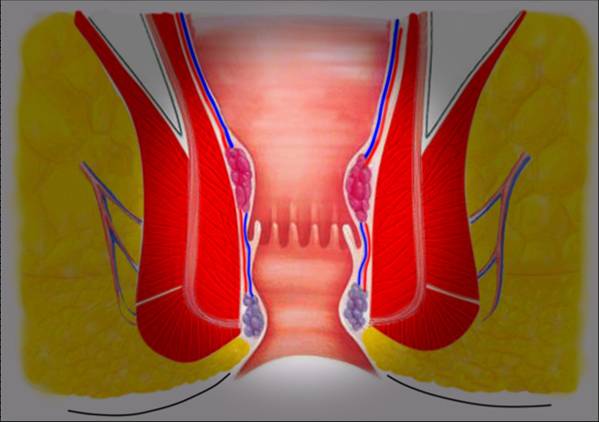Anal fissure is a small longitudinal injury located in the anus at the external-internal passage of the anus between the anoderma (the outer skin) and the anal (internal) mucosa.
INDEX:
1. WHAT IS ANAL FISSURE
2. SYMPTOMS AND SYMPTOMS OF ANAL FISSURE
3. PROCEDURE FOR DIAGNOSIS
4. SANITARY IGNITION INDICATIONS
5. MEDICAL THERAPY
6. SURGICAL TECHNIQUES
7. GENERAL INFORMATION AFTER OPERATION FOR ANAL FISSURE
1. WHAT IS ANAL FISSURE
Anal fissure is a small longitudinal injury located in the anus at the external-internal passage of the anus between the anoderma (the outer skin) and the anal (internal) mucosa.
2. CAUSES AND SYMPTOMS OF ANAL FISSURE
It can have many causes, but a common factor is spasm, that is involuntary contraction of the anal muscle (anal sphincter).
It causes more or less intense pains ranging from a mere burning to violent spasms that occur mostly after defecation with increasing intensity to become an unbearable pain.
In these cases it is difficult to sit, you can not work and get to states of real exasperation.
3. PROCEDURE FOR DIAGNOSIS
A simple visit can diagnose anal fissure: rectal exploration shows a longitudinal wound at the mouth of the anal canal, which in more advanced cases deepens to the sphincter muscle of which the fibers are recognized.
This wound begins a vicious cycle: Pain -> Reflex muscle contraction -> Wound pain worsening -> Increased pain -> and so on ...
It is obvious therefore that to stop this vicious circle it is necessary to reduce the spasm, that is, the contractions of the sphincter muscle.
The first medical approach must be based on:
Hygienic sanitation and medical therapy that is resolving in 80% of cases.
Those who are not responding to therapy are members of the surgery.
4. SANITARY IGNITION INDICATIONS
to. Avoid spicy foods, spices, sausages, chocolate and mainly excesses of coffee (decaffeinated is allowed) and tea.
b. Try to evacuate regularly without getting too hard or diarrhea.
c. Do not sit for long in the cup of the toilet.
d. At the end of the defecation, you must stand up and sit on the bidet DO NOT USE THE HYGIENIC PAPER; Then wash with warm water.
All that relaxes favors healing, the cold worsens the spasm of the anus.
Do at least three times a day baths with warm water for 5-10 minutes.
5. MEDICAL THERAPY
It is based on painkillers, ointments and suppositories, possibly anxiolytics and anti-spasms.
6. SURGICAL TECHNIQUES
The intervention could be preceded by an examination called Anal Manometry.
The most effective is ANALYF SYMPTOMATIC: It is performed in local anesthesia and sedation, a small anal engraving of less than 1 cm to interrupt some fibers of the internal sphincter muscle.
In this way the anus relaxes and this allows the sting to heal.
The pain disappears with the intervention.
The postoperative course is explained in the post-operative instruction sheet.
7. GENERAL INFORMATION AFTER OPERATION FOR ANAL FISSURE by Dr. Carlo Farina
After the surgery, the anal area remains painless thanks to a painkillers treatment at fixed doses and times which will continue to be home and allow for regular life.
Defecation is no longer a worrying event, if it does not happen spontaneously within 2 days, you will be given a mild laxative.
It will have to feed a rich fiber supply and eliminate alcohol, coffee, spices and spicy foods.
To have a soft stomach, it is good to drink at least two liters of liquid per day and eventually to take products that soften the stools (LAEVOLAC).
Work can be taken between the 5th and 10th day after the intervention.
During the postoperative period, the patient will have a regular life avoiding long journeys for seven days, bicycle and motorcycle for 2 weeks.
We recommend for the first 7-10 days to apply an analgesic and curative ointment before and after defecation, (RECTOREPARIL).
It is recommended not to sit on the water for long and not use toilet paper, but only wash with plenty of water and liquid soaps (eg ANONET) or EUCLORINA 1 sachet per liter of water.
Consider the need if you have not already done so, for a preventive purpose, a COLONSCOPY within six months of the intervention.
After surgery the patient can observe one of the following situations:
• Pain, anal burns and rectal, especially if it does not follow painkillers.
• Ecchymosis (blackish color around the anus) that disappears in about two weeks.
• Anal swelling. It is the physiological edema that regresses in a few days.
• Red or pink then yellowish blood loss, which lasts until all incisions (months) are healed. It is advisable to use absorbents.
• Irritation of the skin around the vessel which appears reddened and it causes itching and burning. It manifests itself in people with sensitive skin and

